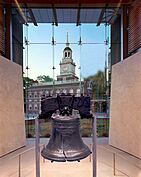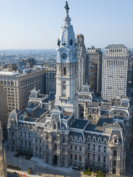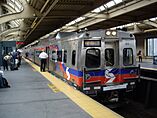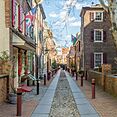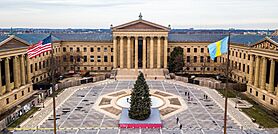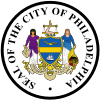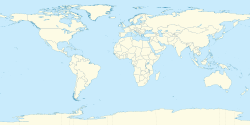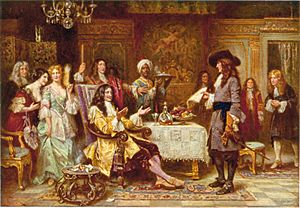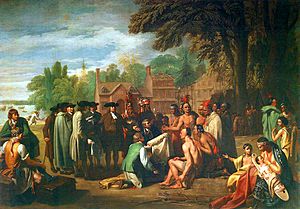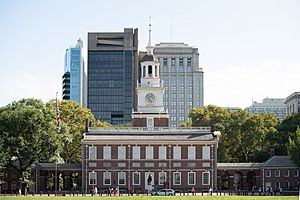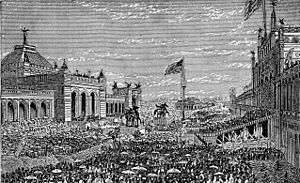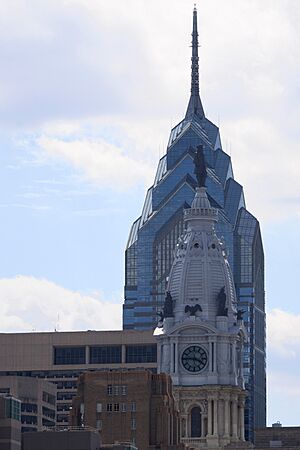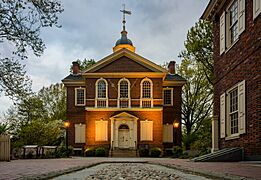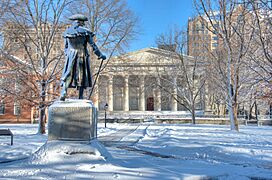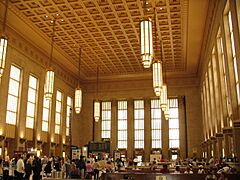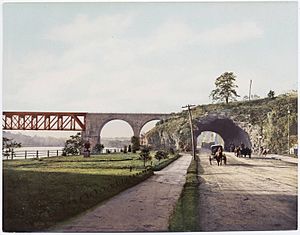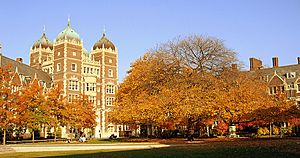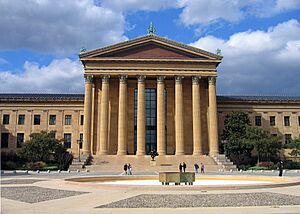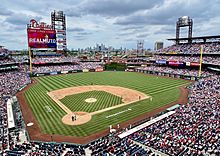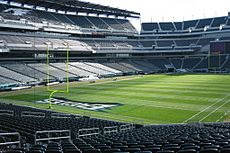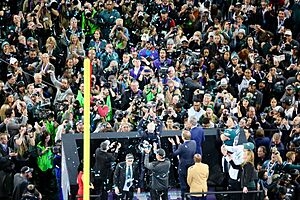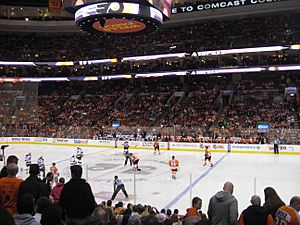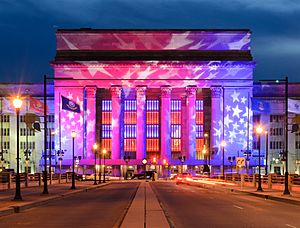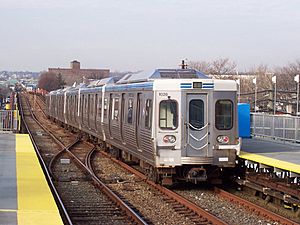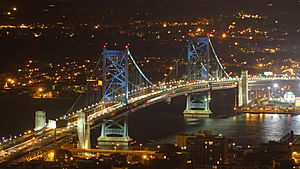Philadelphia facts for kids
Quick facts for kids
Philadelphia
|
|||||
|---|---|---|---|---|---|
|
Consolidated city-county
|
|||||
|
|
|||||
|
|||||
| Etymology: Ancient Greek: φίλος phílos (beloved, dear) and ἀδελφός adelphós (brother, brotherly) ———-——— |
|||||
| Nickname(s):
"Philly", "The City of Brotherly Love", others
|
|||||
| Motto(s):
"Philadelphia maneto" ("Let brotherly love endure" or "... continue")
|
|||||
| Country | United States | ||||
| State | Pennsylvania | ||||
| County | Philadelphia | ||||
| Historic countries | Kingdom of England Kingdom of Great Britain Netherlands Sweden Lenape |
||||
| Historic colony | Province of Pennsylvania | ||||
| Founded | 1682 | ||||
| Incorporated | October 25, 1701 | ||||
| Founded by | William Penn | ||||
| Government | |||||
| • Type | Mayor–council, consolidated city-county | ||||
| • Body | Philadelphia City Council | ||||
| Area | |||||
| • Consolidated city-county | 142.70 sq mi (369.59 km2) | ||||
| • Land | 134.36 sq mi (347.98 km2) | ||||
| • Water | 8.34 sq mi (21.61 km2) | ||||
| Elevation | 39 ft (12 m) | ||||
| Population
(2020)
|
|||||
| • Consolidated city-county | 1,603,797 | ||||
| • Estimate
(2022)
|
1,567,258 | ||||
| • Rank | 10th in North America 6th in the United States 1st in Pennsylvania |
||||
| • Density | 11,936.92/sq mi (4,608.86/km2) | ||||
| • Urban | 5,696,125 (US: 7th) | ||||
| • Urban density | 3,000.8/sq mi (1,158.6/km2) | ||||
| • Metro | 6,245,051 (US: 7th) | ||||
| Demonym(s) | Philadelphian | ||||
| GDP | |||||
| • Philadelphia (MSA) | $518.5 billion (2022) | ||||
| Time zone | UTC−5 (EST) | ||||
| • Summer (DST) | UTC−4 (EDT) | ||||
| ZIP Codes |
19092–19093, 19099, 191xx
|
||||
| Area codes | 215, 267, 445 | ||||
| FIPS code | 42-60000 | ||||
| GNIS feature ID | 1215531 | ||||
Philadelphia, often called Philly, is the largest city in Pennsylvania. It's also the sixth-largest city in the United States, with over 1.6 million people living there in 2020. The city is the main part of the larger Delaware Valley area. This area is home to over 6 million people.
Philadelphia has played a huge role in United States history. It was founded in 1682 by William Penn, an English Quaker who believed in religious freedom. The city was the capital of the Pennsylvania Colony during the time of British rule.
Philadelphia was very important during the American Revolution. It was the meeting place for the nation's founding fathers. The First Continental Congress met here in 1774. The Second Continental Congress also met here, forming the Continental Army and choosing George Washington as its leader in 1775.
On July 4, 1776, the Declaration of Independence was adopted in Philadelphia. The city was under British control for a short time during the war. In 1787, the U.S. Constitution was approved here. Philadelphia was the largest city in the nation until 1790. It also served as the first capital of the United States until 1800.
Today, Philadelphia is important for business, culture, sports, and music. It has many universities and colleges, making it a top place for higher education and academic research. The city is known for its many outdoor sculptures and murals.
Fairmount Park, combined with Wissahickon Valley Park, is one of the largest urban parks in the country. Philadelphia is famous for its arts, food, and history from the colonial and Revolutionary eras. In 2016, over 42 million tourists visited the city. Philadelphia also has five professional sports teams and very dedicated fans.
The Philadelphia area is a major center for biotechnology. The Philadelphia Stock Exchange, founded in 1790, is the oldest stock exchange in the U.S. and a global leader in options trading. 30th Street Station is the third-busiest Amtrak train station in the nation. The city also has Philadelphia International Airport, a major airport, and the growing Port of Philadelphia.
Philadelphia is known for many "firsts" in the U.S. It had the first library (1731), hospital (1751), medical school (1765), and stock exchange (1790). The city is home to 67 National Historic Landmarks, including Independence Hall. Many famous Americans were born or lived in Philadelphia.
Contents
- History of Philadelphia
- Philadelphia's Geography
- People and Culture of Philadelphia
- Philadelphia's Economy
- Education in Philadelphia
- Culture and Arts in Philadelphia
- Sports in Philadelphia
- Media in Philadelphia
- City Infrastructure and Transportation
- Notable People from Philadelphia
- Sister Cities of Philadelphia
- Images for kids
- See also
History of Philadelphia
Early Native American Peoples
Before Europeans arrived in the 1600s, the Philadelphia area was home to the Lenape Indians. Their village was called Shackamaxon. They were also known as the Delaware Indians. Their lands were along the Delaware River and the Hudson Valley.
Most Lenape people were forced out of the region in the 1700s as European colonies grew. Diseases like smallpox also weakened their communities. Many Lenape moved west. After the American Revolutionary War, the U.S. government moved most remaining Lenape to Indian Territory in what is now Oklahoma.
Colonial Beginnings

Europeans first came to the Philadelphia area in the early 1600s. Dutch settlers built Fort Nassau in 1623. Later, Swedish settlers created the colony of New Sweden in 1638. The Dutch took control of the Swedish colony in 1655.
In 1664, an English fleet captured the Dutch colony. The area became part of William Penn's new colony of Pennsylvania in 1682. King Charles II of England gave Penn the land to repay a debt.
Penn, a Quaker, wanted his colony to be a place where everyone could worship freely. He bought the land from the local Lenape people to ensure peace. Penn made a friendship treaty with Lenape chief Tammany.
Penn named the city Philadelphia, which means "brotherly love" in Greek. He wanted it to be a peaceful place. This tolerance helped Philadelphia grow quickly into an important city.
Penn planned the city with a grid plan to keep houses spread out. This was meant to prevent fires. However, people crowded near the Port of Philadelphia on the Delaware River.
In 1701, Penn made Philadelphia an official city. By the 1750s, it was a major trading center. Benjamin Franklin helped improve city services. He started the first fire company, library, and hospital in the nation.
Philadelphia and the American Revolution
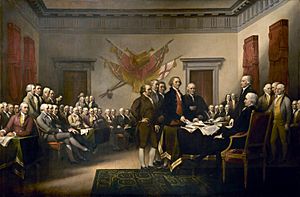
Philadelphia's central location made it a key place for American revolutionaries. By the 1750s, Philadelphia was the largest city and busiest port in British America. It was the second-largest city in the entire British Empire after London.
In 1774, Philadelphia hosted the First Continental Congress. This meeting was held as colonists grew angry with British rule. From 1775 to 1781, Philadelphia hosted the Second Continental Congress.
In what is now Independence Hall, the Declaration of Independence was adopted on July 4, 1776. This document, mostly written by Thomas Jefferson, declared war against the powerful British Army. The Declaration's signing is celebrated every year on July 4th.
After a battle in September 1777, the British Army took control of Philadelphia. The Liberty Bell and other church bells were hidden to prevent the British from melting them down for weapons. The Liberty Bell was hidden in Allentown for nine months.
Two Revolutionary War battles, the Siege of Fort Mifflin and the Battle of Germantown, happened within Philadelphia's city limits. In 1777, the Second Continental Congress adopted the Articles of Confederation in Philadelphia. The Constitutional Convention also met here in 1787 to approve the U.S. Constitution.
Philadelphia served as the capital of the United States for much of the colonial period. It was the capital from 1790 to 1800 while Washington, D.C. was being built. In 1793, a severe yellow fever epidemic killed many people in the city. The U.S. capital moved to Washington, D.C., in 1800.
Philadelphia remained the nation's largest city until 1790, when New York City grew larger. In 1816, the city's free Black community founded the African Methodist Episcopal Church. This was the first independent Black church in the country. New roads, canals, and railroads helped Philadelphia become the first major industrial city in the U.S.
19th and 20th Century Growth
Throughout the 1800s, Philadelphia was home to many industries, especially textiles. Large companies like Baldwin Locomotive Works and the Pennsylvania Railroad were based here. In 1876, the city hosted the Centennial Exposition, the first World's Fair in the U.S.
Many immigrants from Ireland and Germany settled in Philadelphia. They helped lead the first general strike in North America in 1835, winning the ten-hour workday. In the 1840s, thousands of Irish immigrants came to the city, fleeing the Great Famine.
In 1854, the city limits expanded to cover all of Philadelphia County. Later in the 19th and early 20th centuries, immigrants from Russia, Eastern Europe, and Italy arrived. Many African Americans also moved to the city from the southern U.S. during the Great Migration.
By 1950, Philadelphia's population reached over two million. However, it then began to decline as industries changed and people moved to the suburbs. In the late 1970s, neighborhoods began to be revitalized. Areas like Old City and Society Hill were restored.
New skyscrapers were built in Center City starting in the 1980s. Immigrants from around the world began to move to Philadelphia. This helped the city's population start growing again in the 21st century.
Philadelphia's Geography
City Layout and Natural Features
Philadelphia is located at about 40 degrees north latitude and 75 degrees west longitude. The city covers about 142.71 square miles. Most of this is land, with about 6% being water. The main rivers are the Delaware and Schuylkill. There are also creeks like Cobbs, Wissahickon, and Pennypack.
The lowest point in the city is sea level. The highest point is in Chestnut Hill, about 446 feet above sea level. Philadelphia is on the Atlantic Seaboard Fall Line, where the flat coastal plain meets the hilly Piedmont region.
Philadelphia is its own county. It is bordered by six other counties: Montgomery, Bucks, Burlington, Camden, Gloucester, and Delaware County.
City Planning and Architecture
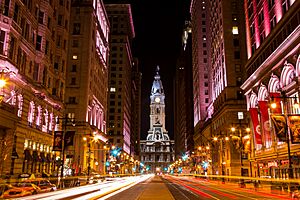
Philadelphia was planned in the 1600s by William Penn's surveyor, Thomas Holme. Center City has a grid pattern of long, straight streets. These streets run east-west and north-south between the Delaware and Schuylkill rivers.
Penn wanted the city to have open spaces. He named many east-west streets after local trees. He also planned five public parks, which were renamed in 1824. These include Penn Square and Washington Square. Center City is the second most populated downtown area in the U.S.
Philadelphia's neighborhoods are grouped into six large sections around Center City. These are North Philadelphia, Northeast Philadelphia, South Philadelphia, Southwest Philadelphia, West Philadelphia, and Northwest Philadelphia. The city's boundaries have not changed much since 1854.
Philadelphia's buildings show many different styles from colonial times to today. Early buildings were made of logs, then brick. In the 1700s, Georgian architecture was popular, seen in Independence Hall.
In the 1800s, Federal and Greek Revival architecture became common. Philadelphia City Hall, built from 1871 to 1901, is in the Second Empire style. The Philadelphia Historical Commission works to protect the city's historic buildings.
In 1932, Philadelphia got the first modern International Style skyscraper in the U.S., the PSFS Building. For a long time, City Hall was the tallest building. But in 1987, One Liberty Place became taller.
Many glass and granite skyscrapers have been built since the 1980s. The Comcast Technology Center, finished in 2018, is the tallest building in the city. It is also one of the tallest buildings in the U.S. outside of New York City and Chicago.
The typical home in Philadelphia is the row house. Row houses were first introduced in the U.S. through Philadelphia in the early 1800s. You can find many types of row houses throughout the city.
-
Elfreth's Alley, developed in 1703, is the nation's oldest residential street.
-
Carpenters' Hall, built 1770-1774 in Georgian architecture style.
-
The Second Bank of the United States, built 1818-1824, showing Greek Revival architecture.
-
Second Empire-style Philadelphia City Hall, built 1871-1901.
-
The Art Deco-style concourse at 30th Street Station, built 1927-1933.
City Parks and Green Spaces
As of 2014, Philadelphia has over 11,000 acres of park space. The city's largest park is Fairmount Park, which includes the Philadelphia Zoo. Fairmount Park and the nearby Wissahickon Valley Park together form one of the largest continuous urban park areas in the U.S. These parks and their historic mansions are listed on the National Register of Historic Places.
Philadelphia's Climate
Philadelphia has a humid subtropical climate. This means summers are usually hot and humid. Fall and spring are mild, and winters are moderately cold. The average yearly snowfall is about 22.4 inches. Some winters have very little snow, while others have big snowstorms.
Rainfall is spread throughout the year. The city gets about 44.1 inches of rain annually. Philadelphia is a moderately sunny city, with about 2,498 hours of sunshine each year.
The average temperature in January is about 33.7°F. In July, the average is about 78.7°F. Temperatures often reach or go above 90°F about 30 days a year. The highest temperature ever recorded was 106°F in August 1918. The lowest was -11°F in February 1934.
People and Culture of Philadelphia
Population and Diversity
As of the 2020 U.S. Census, Philadelphia had 1,603,797 residents. The city's population has been growing since 2006. Many people have moved from New York City to Philadelphia because of its lower cost of living.
Philadelphia is a very diverse city. In 2020, the population was about 39.3% Black, 36.3% White, and 8.7% Asian. About 14.9% of residents were Hispanic or Latino.
Many foreign-born people live in Philadelphia. Between 2000 and 2016, the number of foreign-born residents increased by 69%. The top countries of origin for immigrants are China, the Dominican Republic, Jamaica, India, and Vietnam.
Philadelphia has the second-largest Irish and Italian populations in the U.S. after New York City. South Philadelphia is known for its large Italian-American community and the famous Italian Market.
Pennsport and Gray's Ferry are well-known Irish neighborhoods. Port Richmond is a center for the Polish-American community. Northeast Philadelphia has Irish, Jewish, and Russian populations.
Philadelphia's Black American population is the fourth-largest in the country. West Philadelphia and North Philadelphia are largely African-American neighborhoods. Many African-American Muslims live in Philadelphia.
The Puerto Rican population in Philadelphia is the second-largest on the U.S. mainland. Many Puerto Ricans live in North Philadelphia. Mexican and Central American populations are found in South Philadelphia.
Philadelphia's Asian American population includes people from China, India, Vietnam, South Korea, and other countries. Chinatown in Center City is a vibrant area. There are also Vietnamese, Cambodian, and Korean communities.
The city has a welcoming LGBTQ+ community. The "Gayborhood" near Washington Square has many gay and lesbian-friendly businesses.
Religious Beliefs
In a 2014 study, 68% of Philadelphia's population identified as Christian. This includes many different Protestant churches and Catholics. Philadelphia has historical ties to the Quakers, who still have a presence in the city.
Other religions like Judaism, Hinduism, Islam, Buddhism, and Sikhism are also practiced. Philadelphia has one of the largest Muslim populations among U.S. cities. About 24% of the population reported having no religious affiliation.
Languages Spoken
As of 2010, most Philadelphia residents (79.12%) spoke English at home. Spanish was the second most common language, spoken by 9.72% of residents. Other languages spoken include Chinese, Vietnamese, Russian, and French. In total, over 20% of Philadelphia's population speaks a language other than English at home.
Philadelphia's Economy
Philadelphia is a major economic center for Pennsylvania and the surrounding four-state Delaware Valley region. The city's economy benefits from its close connections to other large cities on the Eastern Seaboard.
Philadelphia's economy includes financial services, health care, biotechnology, information technology, trade, transportation, manufacturing, and tourism. The Philadelphia area is one of the top five places in the U.S. for venture capital investments.
The city's two largest employers are the federal and city governments. The University of Pennsylvania is the largest private employer, followed by the Children's Hospital of Philadelphia.
Companies and Industries
The Philadelphia Stock Exchange, now owned by Nasdaq, is a global leader in options trading. Philadelphia is home to the headquarters of Comcast, a large telecommunications company. Other major companies include insurance groups like Cigna, food services company Aramark, and clothing retailers like Urban Outfitters.
The Philadelphia area is also a hub for information technology and biotechnology. Many new life sciences companies are starting here.
Tourism in Philadelphia
Philadelphia's rich history attracts many visitors. Independence National Historical Park, which includes the Liberty Bell and Independence Hall, is a very popular site. In 2016, over 5 million people visited this park.
The city welcomed 42 million tourists in 2016. These visitors spent $6.8 billion, which had a big economic impact on the city.
Trade and Transportation
Philadelphia International Airport is a major airport for both domestic and international flights. It has been expanded to handle more passengers. The Port of Philadelphia has also grown, doubling its shipping capacity.
Philadelphia's 30th Street Station is the third-busiest Amtrak train station in the nation. It serves over 4 million train passengers each year. This station connects to Amtrak, SEPTA, and NJ Transit lines.
Education in Philadelphia
Schools for Kids and Teens
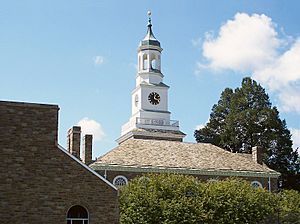
Education in Philadelphia is provided by public and private schools. The School District of Philadelphia runs the public schools. It is the eighth-largest school district in the U.S., with over 142,000 students.
The number of students in district-run schools has decreased over the years. This led to the closing of some public schools in 2013. However, graduation rates have been increasing.
Colleges and Universities
Philadelphia has a large number of college students. More than 120,000 students are enrolled in colleges and universities within the city. There are over 80 higher education institutions in the Philadelphia region.
The University of Pennsylvania is a famous Ivy League university in the city. It is one of the oldest universities in the U.S. Other large universities include Temple University and Drexel University. Philadelphia is also home to five medical schools.
Culture and Arts in Philadelphia
Historic Sites and Museums
Philadelphia has many national historical sites related to the founding of the United States. Independence National Historical Park is a UNESCO World Heritage Site. It includes Independence Hall, where the Declaration of Independence was signed, and the Liberty Bell.
Other historic sites include the homes of famous people and early government buildings. Philadelphia has 67 National Historic Landmarks, which is the third most of any city in the country.
Major science museums include the Franklin Institute, the Academy of Natural Sciences, and the Mütter Museum. History museums include the National Constitution Center and the Museum of the American Revolution. Philadelphia is also home to the first zoo and hospital in the U.S.
Art and Entertainment
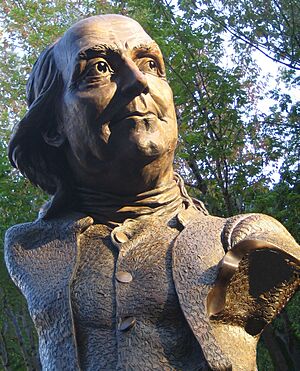
Philadelphia has several art museums. The Philadelphia Museum of Art is one of the largest art museums in the world. The famous "Rocky Steps" lead to its main entrance.
Annual events include the Philadelphia Film Festival and the 6abc Dunkin' Donuts Thanksgiving Day Parade. The Mummers Parade is a long-standing folk parade held every New Year's Day.
The Avenue of the Arts in Center City has many restaurants and theaters. The Kimmel Center for the Performing Arts is home to the Philadelphia Orchestra. The Academy of Music hosts Opera Philadelphia. The Walnut Street Theatre is said to be the oldest continuously operating theater in the English-speaking world.
Philadelphia has more public art than any other American city. The Mural Arts Program has funded over 2,800 murals, making the city famous for its outdoor art.
Music Scene
The Philadelphia Orchestra is considered one of the top five orchestras in the United States. They perform at the Kimmel Center for the Performing Arts. The Curtis Institute of Music is one of the world's best music schools.
Philadelphia has greatly influenced music of the United States. The TV show Bandstand, later renamed American Bandstand, started here in 1952. Hosted by Dick Clark, it helped launch the careers of many teen idols.
Philly soul music from the 1960s and 70s was a highly produced style of soul music. It influenced later music like disco. Philadelphia has also hosted major concerts like Live Aid in 1985 and Live 8 in 2005. Many famous rock and pop musicians are from Philadelphia.
Local Cuisine

Philadelphia is famous for its unique foods. These include hoagies, stromboli, roast pork sandwich, scrapple, soft pretzels, water ice, and cheesesteak sandwiches. The cheesesteak was created by Italian immigrants in the 1930s.
Pat's King of Steaks is known for inventing the cheesesteak. It faces its rival, Geno's Steaks, in the Italian Market.
McGillin's Olde Ale House, opened in 1860, is the oldest continuously operated tavern in the city. The City Tavern is a replica of an 18th-century building. It serves authentic 18th-century recipes.
The Reading Terminal Market is a historic food market founded in 1893. It is one of the oldest and largest markets in the country. It has over a hundred merchants selling local and ethnic foods.
Philadelphia's Unique Dialect
Many linguists believe the traditional Philadelphia accent is one of the most unique in North America. The Philadelphia dialect is spoken throughout the Delaware Valley and South Jersey. It shares similarities with the New York accent. This accent is especially common in Irish American and Italian American working-class neighborhoods. Philadelphia also has its own special slang words.
Sports in Philadelphia
Philadelphia has teams in all four major U.S. sports leagues. These are the Philadelphia Phillies (baseball), the Philadelphia Eagles (football), the Philadelphia Flyers (hockey), and the Philadelphia 76ers (basketball). The Phillies, formed in 1883, are the oldest team in American professional sports to continuously play under the same name in the same city.
The Philadelphia area also has the Philadelphia Union soccer team, which plays in Major League Soccer (MLS). Philadelphia is one of only 13 U.S. cities to have won championships in all four major leagues.
After a long wait, the Phillies won the 2008 World Series. Then, the Eagles won their first Super Bowl in 2018.
Rowing is very popular in Philadelphia. Boathouse Row on the Schuylkill River is a symbol of the city's rowing history. Philadelphia hosts many rowing competitions, including the annual Dad Vail Regatta and the Stotesbury Cup Regatta.
Philadelphia is home to the Philadelphia Big 5, a group of five college basketball programs. These include La Salle, Penn, Saint Joseph's, Temple, and Villanova. Villanova has won the NCAA Division I men's basketball tournament three times. Philadelphia will also be a host city for the 2026 FIFA World Cup.
| Team | League | Sport | Venue | Capacity | Founded | Championships |
|---|---|---|---|---|---|---|
| Philadelphia Phillies | MLB | Baseball | Citizens Bank Park | 46,528 | 1883 | 1980, 2008 |
| Philadelphia Eagles | NFL | American football | Lincoln Financial Field | 69,176 | 1933 | 1948, 1949, 1960, 2017 |
| Philadelphia 76ers | NBA | Basketball | Wells Fargo Center | 21,600 | 1963 | 1966–67, 1982–83 |
| Philadelphia Flyers | NHL | Ice hockey | Wells Fargo Center | 19,786 | 1967 | 1973–74, 1974–75 |
| Philadelphia Union | MLS | Soccer | Subaru Park | 18,500 | 2010 | none |
| Philadelphia Wings | NLL | Lacrosse | Wells Fargo Center | 19,786 | 2018 | none |
Media in Philadelphia
Newspapers and Publications
Philadelphia has two main daily newspapers: The Philadelphia Inquirer and the Philadelphia Daily News. The Inquirer was first published in 1829, making it one of the oldest newspapers in the country.
Other local publications include Philadelphia Tribune for the African-American community, Philadelphia magazine, and Philadelphia Weekly. There are also newspapers for the LGBT, Jewish, and Latino communities.
Radio and Television
The first commercial AM radio stations in Philadelphia began broadcasting in 1922. Today, the city has many FM and AM radio stations. Popular stations play adult contemporary, sports talk, classic rock, and urban adult contemporary music. There are also public radio stations for news, classical music, and jazz.
Philadelphia's first television station, W3XE, launched in the 1930s. In 1952, the show Bandstand premiered in Philadelphia. It later became the national show American Bandstand. Today, all major U.S. commercial TV networks have affiliates in Philadelphia. The city's media market is the fifth-largest in North America.
City Infrastructure and Transportation
Getting Around Philadelphia
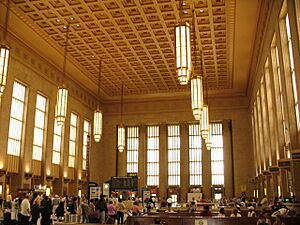
Philadelphia is served by SEPTA, which runs buses, trains, subways, trolleys, and electric buses. SEPTA's services cover Philadelphia and its surrounding counties. The city's subway system has two main lines: the Market–Frankford Line and the Broad Street Line.
Philadelphia's 30th Street Station is a major train station for Amtrak. It is the third-busiest Amtrak station in the country. It also connects to SEPTA and NJ Transit lines.
The PATCO Speedline provides rapid transit service to parts of New Jersey from stations in Center City.
Airports and Roads
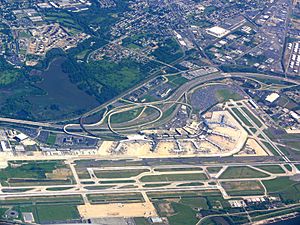
Philadelphia has two airports. Philadelphia International Airport (PHL) is the larger one. It offers domestic and international flights. It is the busiest airport in Pennsylvania. SEPTA's Airport Line connects the airport to Center City.
Northeast Philadelphia Airport (PNE) is a smaller airport for general and corporate flights.
Major highways like Interstate 95 and Interstate 76 serve Philadelphia. I-95 runs along the Delaware River, connecting the city to other major East Coast cities. I-76 runs along the Schuylkill River, providing access to areas west of the city.
Several bridges connect Philadelphia to South Jersey across the Delaware River. These include the Walt Whitman Bridge and the Benjamin Franklin Bridge.
City Services
The Philadelphia Water Department (PWD) provides drinking water, wastewater collection, and stormwater services. PWD gets its drinking water from the Delaware and Schuylkill rivers.
PECO Energy Company provides electricity to about 1.6 million customers in the Philadelphia area. Philadelphia Gas Works (PGW) is the largest city-owned natural gas utility in the nation. It serves over 500,000 homes and businesses in Philadelphia.
Notable People from Philadelphia
Sister Cities of Philadelphia

Philadelphia has eight official sister cities around the world. These relationships help promote cultural exchange and understanding.
| City | Country | Date |
|---|---|---|
| Florence | Italy | 1964 |
| Tel Aviv | Israel | 1966 |
| Toruń | Poland | 1976 |
| Tianjin | China | 1979 |
| Incheon | South Korea | 1984 |
| Douala | Cameroon | 1986 |
| Nizhny Novgorod | Russia | 1992 |
| Frankfurt | Germany | 2015 |
Philadelphia also has three partnership cities or regions:
| City | Country | Date |
|---|---|---|
| Kobe | Japan | 1986 |
| Abruzzo | Italy | 1997 |
| Aix-en-Provence | France | 1999 |
The Sister Cities Park in Logan Square honors Philadelphia's sister cities. The Chinatown Gate, built in 1984, is a symbol of the sister city relationship with Tianjin, China.
Images for kids
See also
 In Spanish: Filadelfia para niños
In Spanish: Filadelfia para niños



